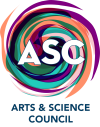Sign Me Up! Public Art Places ‘A Good Sign’ Along North Tryon Street
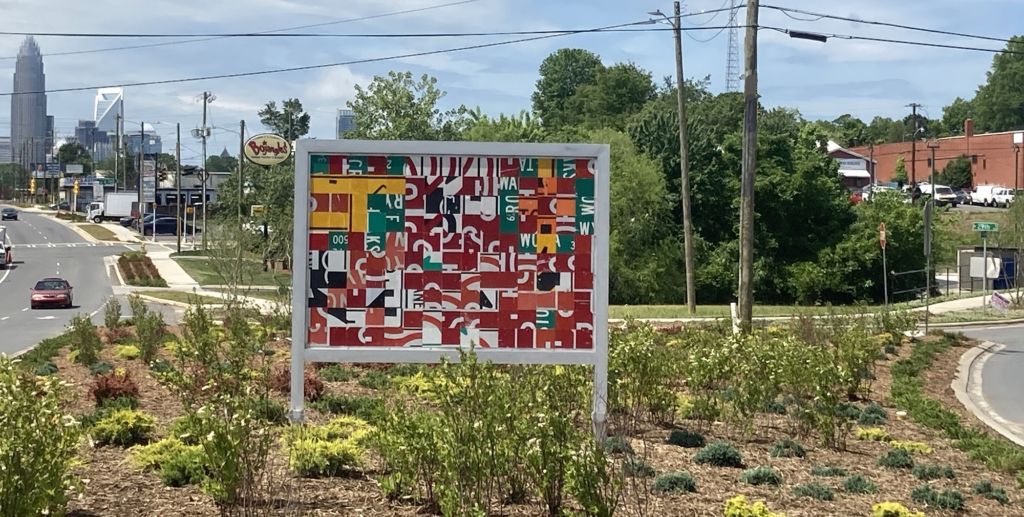
By Page Leggett
Signs are everywhere – on interstates, on highways and byways, on restaurants and retail establishments.
No trespassing. Wrong way. Masks required. We encounter so many signs in our daily lives that we can start to tune them out.
Unless a sign stands out.
That’s what the husband/wife artist team Wowhaus (Ene Osteraas-Constable and Scott Constable) aimed to do along the North Tryon business corridor with its “A Good Sign” project, funded by the city of Charlotte’s 1% for public art ordinance and managed by ASC.
(In 2002 and 2003, the Mecklenburg County Board of Commissioners and the Charlotte City Council adopted ordinances that appropriate 1% of eligible capital improvement project funds for public art. ASC manages the program.)
The multifaceted North Tryon business corridor public art project was completed in June. “A Good Sign” is a series of art elements integrated into the streetscape of North Tryon that enlivens this major Charlotte thoroughfare. Designed to appeal to passersby on foot, on bikes or in vehicles, the artwork is integrated in the road, medians and sidewalks, creating a series of unique discoveries throughout the streetscape.
These are signs worth paying attention to. These are signs that enhance, rather than clutter, the landscape.
GOOD SIGNS
“One of the exciting elements of this project was that the city was pursuing having the streetscape Greenroads®-certified, which is basically like LEED certification for buildings – but for roadways,” said Todd Stewart, ASC’s vice president of public art.
He goes on to explain the rationale behind the improvement project: “The city was taking a section of North Tryon and splitting it through a median and turning it into a ‘one-way pair’ so that traffic would flow one way out of Charlotte and one way into Charlotte separated by this median.”
The accompanying “A Good Sign” project is comprised of:
- Landmark “Good Sign” sculptures in medians. You’ll read more about this “quilting project” later in the story.
- “Good Signs of Nature” along sidewalks. “These mirror the traffic signs and road signs that you’d see along any streetscape,” said Stewart. “But instead of alerting you to different traffic orientations or dangers, they point to local flora, fauna and some of these sustainability efforts the city undertook.”
“They’re simple,” said Wowhaus’ Ene Osteraas-Constable. “They’re small street signs, but what they do cumulatively is, as you walk through the streetscape, they give you a different perspective on the environment. We collaborated with the Charlotte Department of Transportation (CDOT) landscape architects in selecting beneficial plantings that provide food and habitat for wildlife. And yes, there is wildlife in the urban ecosystem.”

- Beautified crosswalk, which heralds entry to the business corridor. “Wowhaus designed this really beautiful crosswalk that we put at the intersection of Dalton Avenue and North Tryon,” Stewart said. “It’s based on the cardinals that are indigenous to our area and is comprised of a really beautiful, repeating pattern. It was actually one of the trickier components of the project to pull off because there was so much that had to go into making sure it was meeting safety standards for the CDOT and N.C. DOT.”
“The crosswalk is a humble art form,” Osteraas-Constable said. “But it’s significant in that it really signals a welcome to pedestrians. The whole redesign of the streetscape was created to foster pedestrian use. It really softens the landscape.”
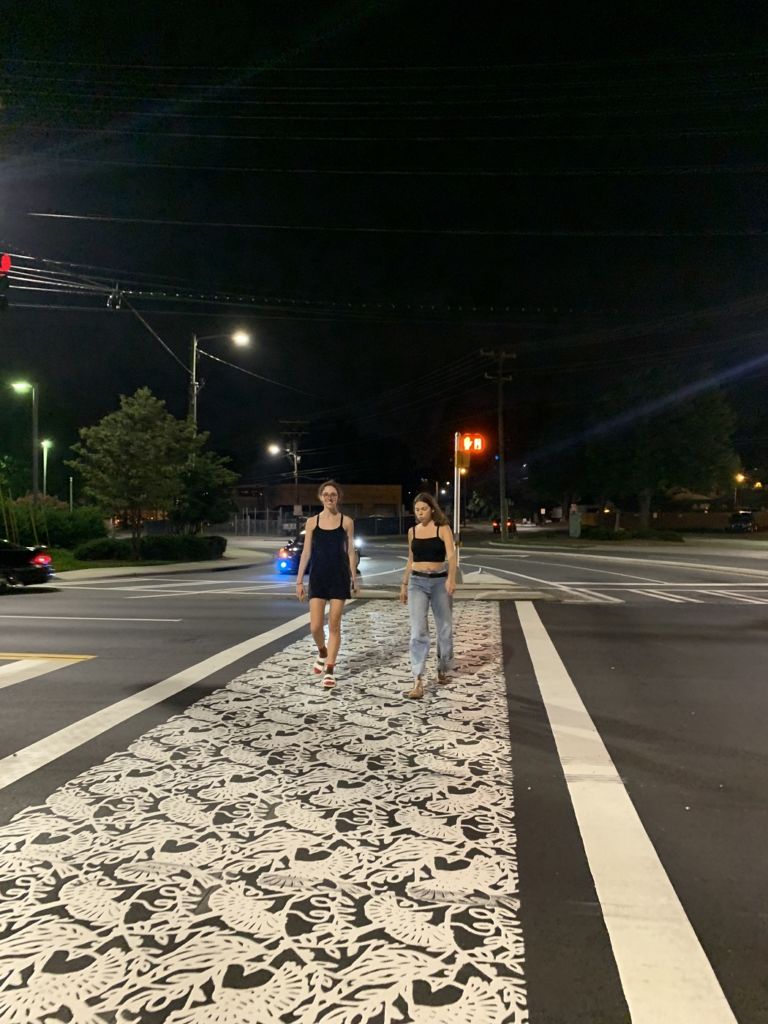
- “Green Zones” along road and sidewalks featuring beneficial plantings (designed by Wowhaus in collaboration with CDOT landscape designers)
BRINGING ART TO THE PEOPLE
The North Tryon business corridor project resulted in street improvements along North Tryon Street from Dalton Avenue to 30th Street. Enhancements include safer pedestrian crossings through traffic-calming features, crosswalks, new sidewalk, planting strips, planted medians, landscaping, decorative lighting, reduced number of and/or size of driveway openings, bike lanes and utility relocations.
Wowhaus was commissioned to create integrated streetscape art elements that primarily engage pedestrian and bicycle traffic while providing “art experiences” for motorists as well. The artists developed Good Signs, a series of artistic interventions along North Tryon, to support the city’s environmentally sustainable efforts in both streetscape design and construction.
“This one was a little tricky, because whereas most of our artworks are on just one site, this was a stretch of road,” Stewart said. “Wowhaus was challenged from the beginning in terms of siting the artwork and how do you create visual references throughout it?”
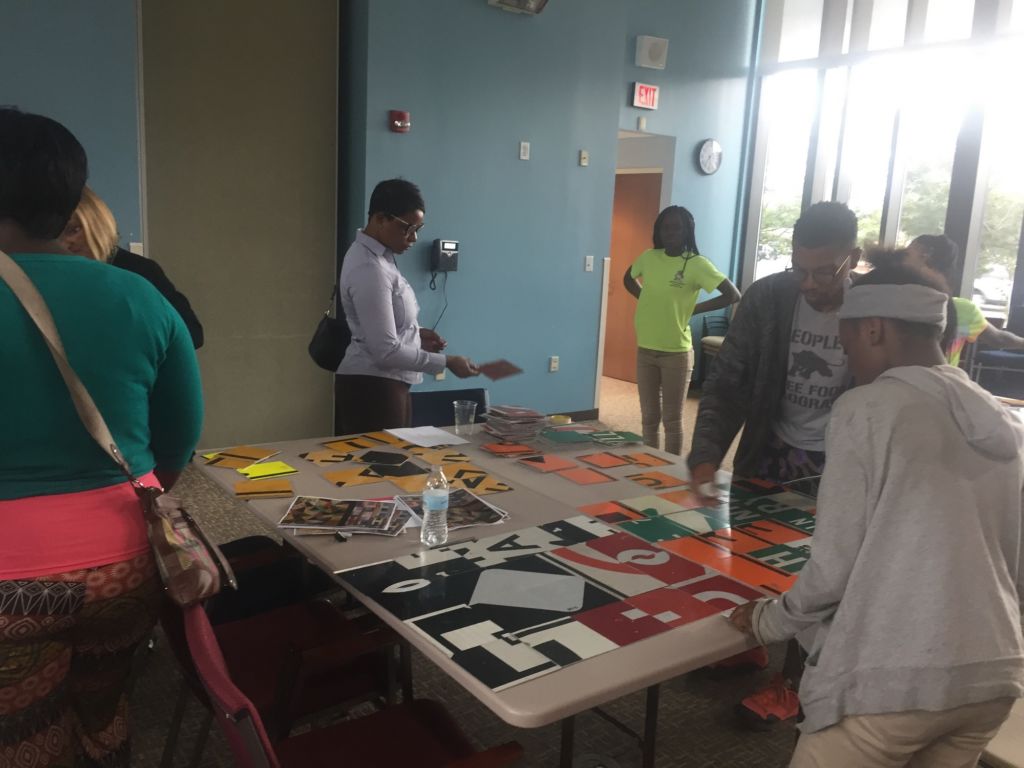
As always, community input was an important part of the process. Wowhaus facilitated three community workshops to source conceptual inspiration and involve attendees in the design process. These meetings also served as opportunities for ASC and Wowhaus to update the community on the project’s development.
WOWING US
The Oakland, California-based duo knows Charlotte better than you might think. They were McColl Center artists-in-residence in 2015. They’d walked the North Tryon corridor many times before they got the commission. Before there was even a commission to get.
This isn’t even the couple’s only site-specific artwork in Charlotte. Charlotte Center City partners hired Wowhaus to create the master public art plan for South End’s Rail Trail. And in 2015, a $400,000 grant from ArtPlace America helped the McColl Center create and enhance Brightwalk’s art and ecology campus. “Scuppernong Commons” is a pocket park/grape arbor by Wowhaus.
But there’s no sign that reads, “Don’t touch the grapes.” Picking them is encouraged; McColl officials envision neighbors making scuppernong jelly.
“What I love about this whole trajectory is it epitomizes what can be done with arts and community,” said Osteraas-Constable. “We were in Charlotte for three months working on a site responsive work at Brightwalk, and we did a bunch of community engagement at the McColl Center and a lot of research.
“The Commons area was created for community gathering,” continued Osteraas-Constable. “The vision was to introduce an edible native grape back into the cityscape, and the long-term vision was that these grapes would be used within the community.”
Wowhaus is always thinking about how to connect people to the environment. What they’ve done, in part, is create “a visual reference for all the sustainability development that the city was doing,” Stewart said. “Sometimes, that stuff can go unseen. So, we’re pointing to the local ecology, the wildlife, the flora and fauna around this area. Wowhaus was an excellent team to work with for this.”
A CONTEMPORARY QUILTING BEE
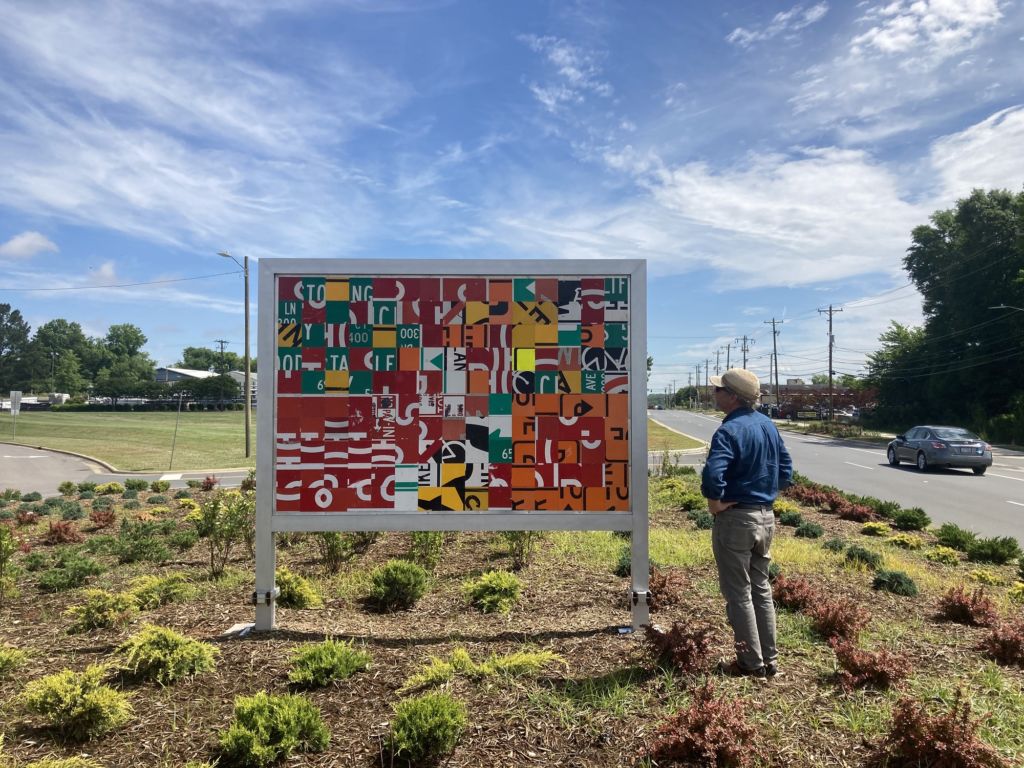
Tom Russell, program manager for the city of Charlotte, is a fan, too.
“They recycled scrap metal and combined it in such a beautiful way,” he said. “Recycled materials don’t cost as much, so they were able to do more with less.”
He’s referring to the “quilts” envisioned by Wowhaus and designed by North Tryon neighbors. ASC conducted a series of quilting workshops with local community members “where Wowhaus led them through a pattern-making design process,” Stewart said. “They took the 6-inch squares and were able to lay them out in different patterns. We had a great turnout; people were really excited about these ‘recycled roadside quilts.’ Each sign is front and back so ingoing and outgoing traffic can see them.”
“One of the workshops was at Roof Above,” he continued. “This was art therapy for our houseless neighbors and it worked really well.”
The quilts have the “ethos of reclaiming materials, and the whole focus of this project is an environmentally sustainable approach to streets,” Osteraas-Constable said. “The concept is to upcycle materials but also use sustainable design principles in the design of the road. The key other aspect of the artwork is that it’s ecologically oriented. So, we actually think that this is a model that could be replicated citywide, if not nationwide.”
INSPIRED BY THE PAST
Wowhaus isn’t just interested in art and the environment. The team takes history into account when they’re placemaking, too.
“One of the first things that came to mind was thinking about creating gateway pieces that reflected the richness of the community, the multi-storied history and ecology of the site,” said Osteraas-Constable. “And North Tryon was an old Catawba road. It was a major thoroughfare for the First Peoples and then the first immigrants and it’s still a major thoroughfare. People still walk North Tryon. It’s different people in different times.”
“But what was really striking to us that this was already an historic thoroughfare,” she continued. “So, our vision was to activate the corridor and reflect the potential for understanding North Tryon in this context. The first element you’ll see are the good sign quilt sculptures, and they herald the entry. They honor the tradition of being resourceful and creative with what you have.”
Art, Osteraas-Constable said, can be a catalyst for dialogue, action and raising awareness around important issues, such as strengthening efforts to combat climate change in cities.
“I know that’s a sweeping statement and I know these are very small pieces, she said, “but if you think about it in the context of the larger cityscape, if the whole city had good signs of nature, you’d start to look at the environment differently.”

